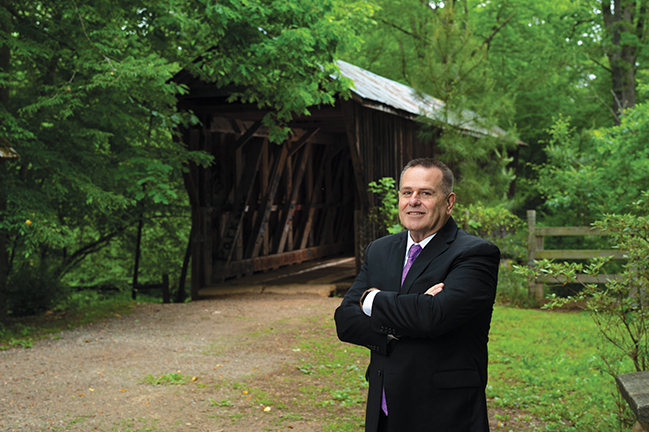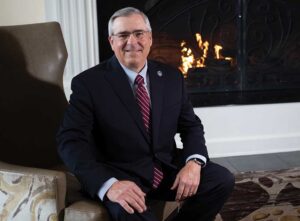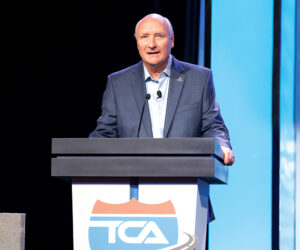Want to talk about slipping in right under the wire? When members of the Truckload Carriers Association met Feb. 29-March 3 for their annual convention, little did they realize that within only a few days, the United States would become part of a global crisis now known as the COVID-19 pandemic. The TCA convention would be among the last face-to-face assemblage within the trucking industry — perhaps even within all major U.S. business sectors — before the country replaced handshakes and hugs with social distancing and quarantines. It was in this environment that Dennis Dellinger began his term as TCA chairman. Under normal circumstances, the incoming chairman would face an arduous travel schedule and a whirlwind of meetings. Instead, virtual reality set in. That did not stop Dellinger from carrying on with his duties from Cargo Transporters’ headquarters in Claremont, North Carolina. In this second chat of his chairmanship, Dennis talks about the impact the COVID-19 pandemic has had on his job and the trucking industry, speaks to the importance of the new hours of service rule, and elaborates on how the trucking industry has stepped forward in a big way during the pandemic.
As we conduct this interview, you’ve just completed your third month as chairman. Share with our readers what that experience has meant to you, some of the things you’ve accomplished during that short time frame, and what you will be working on in the next couple of months.
Six months ago, as we prepared and went through our leadership transition discussions, COVID-19 was not a familiar word to me, nor to many others in our industry. We, as an industry and an association, discovered quickly that we were in unchartered territory by early March and dealing with many unknowns. TCA had to react quickly and decisively to become a resource and conduit of timely and relative information surrounding the effects that COVID-19 was having on the truckload environment and our overall economy. Amid this pandemic, accomplishments may be hard to measure, but through collective collaboration and leadership, TCA will be a stronger association. The challenge moving forward is to promote our agenda and platform as our country slowly begins its reopening process.
Under normal circumstances, at this point in your tenure you would have spent much of the time on the road, attending Truckload Carriers Association meetings and visiting with the TCA staff and with TCA members. How has COVID-19 impacted the manner in which you are carrying out your duties?
I have continued to report to the office on a daily basis, which has given me a sense of normalcy in a world far from that. I am a very social person, having come from a large family, and thrive being around people. The hardest adjustment was respecting the safety of our employees, vendors, and customers by choosing not to have face-to-face meetings and discussions during the stay-at-home orders. I was looking forward to my TCA travels this year; yet I realize we are in different times, and this pandemic has highlighted the necessity for effective communication systems. Those of us baby boomers and Gen Xers have been forced to move into the world of millennials relative to communications.
I know you have spent a lot of time in virtual meetings and on the phone with TCA members. From your perspective and the perspective of what you’ve learned thus far, what are the top two or three ways in which COVID-19 has impacted operational aspects of the truckload industry?
I think each of our companies has been impacted in many different ways. The difference could vary based on the regions of the country in which you operate, the truckload segment of which you are a part, and/or the commodities you transport. While fuel cost and its availability has been a positive impact, the negatives include lower freight volumes, cash flow issues related to extended terms or even no payment, and limited forecasting that tilts the scales, creating opportunities at a level that may not have existed six months ago prior to COVID-19. What has become most evident is that our drivers are essential. Our industry has always recognized this, but I am encouraged knowing it is being recognized outside our industry.
There have been many examples of how trucking has stepped forward to respond to the urgent needs of Americans during this crisis in terms of food, medicine, and other supplies. In your opinion, is this changing the public’s perception of the trucking industry?
It is my opinion that the public has seen the necessity of our industry and the commitment of our drivers. As I shared before, my involvement at TCA began with the Image and Communications Committee. I have always believed in our industry drivers. As a whole, they are characterized as committed, humble, and trusting individuals. They see value and a sense of duty in their respective workdays. To recognize them personally might get you the response, “I’m just doing my job.” Let’s hope we can ride the momentum and sustain this positive perception for our highway heroes and the companies they represent. I am proud to be a part of this industry.
Will an enhanced public image of the industry attract new drivers and help alleviate the driver shortage?
There is no silver bullet that will alleviate the driver shortage as we define it today, but anything that may garner positive attention will create interest. We could be on the cusp when high school graduates look to vocations that do not require a college education. The trend over the past several years seems to be leaning toward technical schools and training for skilled labor. If they turn toward opportunities in our industry that pay higher wages than those competing industries, we may see improvement.
Speaking of the driver shortage, a recent study revealed that company driver pay has increased $6,000 annually between 2017 and 2019. How will that impact the recruitment of new drivers to the industry?
Any increase to the average annual salary of our professional truck drivers should be viewed as a good thing, but at the same time, it cannot be construed as the only factor that impacts the recruitment strategies of potential drivers. As motor carriers, we stress quality of life, family time, and additional benefits that coincide with annual salary in an effort to attract quality drivers. The impacts of the #ThankATrucker efforts have raised the bar on how our drivers are perceived and should continue to permeate across the country, as the general public now recognizes that everything they own has been on a truck at some point in its life cycle. This movement certainly helps the recruitment process go that extra mile (pun intended) when exposing this profession to the people across the nation that could be looking for new careers as our society moves toward getting back to work.
In recent weeks, the Federal Motor Carrier Safety Administration has made two significant announcements. Let’s address them one at a time. First is the new final rule on hours of service that many believe will provide much-needed flexibility in day-to-day trucking operations. Please address the major changes in the rule and how those changes will impact the industry.
As a truckload carrier, the most important aspect of the new provisions is the integration of flexibility into the regulations. For years, we have communicated the need to be able to stop the 14-hour clock so that our drivers have the opportunity to address issues like detention time, congestion, and bad weather they may encounter on a daily basis. The incorporation of the 7-3 split allows drivers the ability to now address some of these issues without the continuous countdown of that on-duty window. While the new flexibility provision is not ultimate flexibility, it certainly represents a start to new data-driven rules that should allow our industry to improve upon its safety record. As we continue to interpret the data generated by the electronic logging devices (ELDs), our industry will be able to make the argument that even more flexibility will be needed in the future. This recent rule change adds credence to the fact the ELD merely makes our industry compliant, but the HOS rule itself, if implemented correctly, can make our industry safer.
The second announcement concerns crash accountability. It is a fact that as many as 75% of the accidents involving a large truck and a passenger vehicle have been determined to be the fault of the passenger vehicle; yet regardless of fault, those accidents have a negative impact on motor carriers’ Compliance, Safety, Accountability (CSA) score. As a result of its Crash Preventability Determination Program (CPDP), motor carriers can submit a request for data review in an effort to have a crash deleted from its CSA score. Please speak to the importance of this new program.
The Crash Preventability Determination Program was derived from the successful demonstration project that FMCSA had implemented in August of 2017. The program has expanded from what it was to now include even more accidents for consideration. In a nutshell, it becomes important for carriers to be judged correctly for accidents that are inherently not their fault, which is what this program is designed to do. Our industry should never have a problem publicizing its safety programs; however, we, as an industry, must insist that the publication of our crash data should be accurate and true. FMCSA will make a preventability determination based upon the data that is presented to them by carriers. It certainly emphasizes the age-old data that you referenced in your question about accident fault, and clearly paints a more accurate picture in regard to the safety performance of carriers.
There are a few key things to note. First and foremost, just because you submit an accident for review does not necessarily mean the Agency will side with you. It is important for everyone to submit as much information as they have available. Second, more carriers need to be involved in this program. The original demonstration project netted just over 4,000 unique motor carriers submitting accidents for review. As an industry with more than 500,000 registered carriers operating on our nation’s highways, less than 1% of our industry participated, which shows this is something for which we need to spread more awareness.
Speaking of CSA, the program is turning 10 years old. Is it time to review where CSA has been helpful in improving safety on the nation’s highways?
CSA is already 10 years old? Wow, time flies. That review is already taking place through the DOT’s Office of Inspector General and incorporating “Item Response Theory” (IRT) into the scoring measure. This could theoretically improve the program, as IRT is intended to account for variables better than the previous scoring system. The Agency is testing the IRT model as we speak, with the results expected sometime this fall. The concern with IRT will almost always be the same that occurred with the original program: The data generated may be wholly biased based on your operating area. Any program designed to measure a carrier’s safety performance should strive to be as accurate as possible when painting that portrait. That being said, if the data is not entirely correct and has some shortcomings to it, the program, as a whole, will suffer. Designing an accurate system has been problematic for years, even going back to the old Safestat program; however, it does seem as though improvements are at hand, and the Agency is genuinely interested in any improvements to this system.
On a personal note, are you enjoying your term as TCA chairman, and how has it impacted your professional and personal life?
Even though outside forces have changed the complexity, TCA must move forward and serve its membership. It is with that same commitment that I am here to serve TCA’s membership and learn along the way. I know that I have truly been blessed, and being a part of TCA has further substantiated that for me. Sherel and I have missed seeing many of you, and look forward to the day that we can once again gather together.
Lyndon Finney’s publishing career spans over 55 years beginning with a reporter position with the Southwest Times Record in Fort Smith, Arkansas, in 1965. Since then he’s been a newspaper editor at the Southwest Times Record, served five years as assistant managing editor of the Arkansas Democrat-Gazette in Little Rock and from November 2004 through December 2019 served as editor of The Trucker. Between newspaper jobs he spent 14 years as director of communications at Baptist Health, Arkansas’ largest healthcare system. In addition to his publishing career he served for 46 years as organist at Little Rock’s largest Baptist church.








